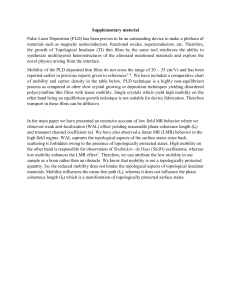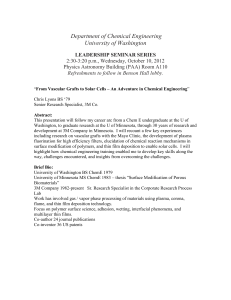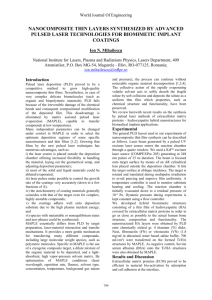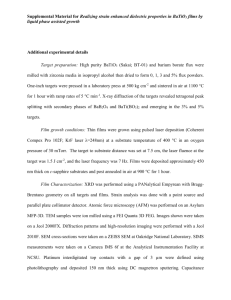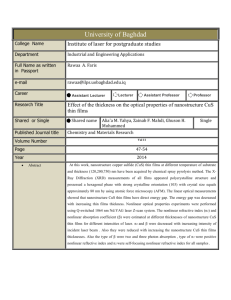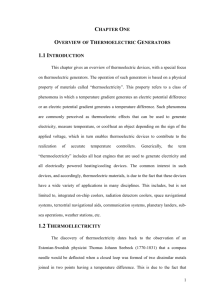Pulsed laser deposition of Bismuth Telluride compounds for human
advertisement
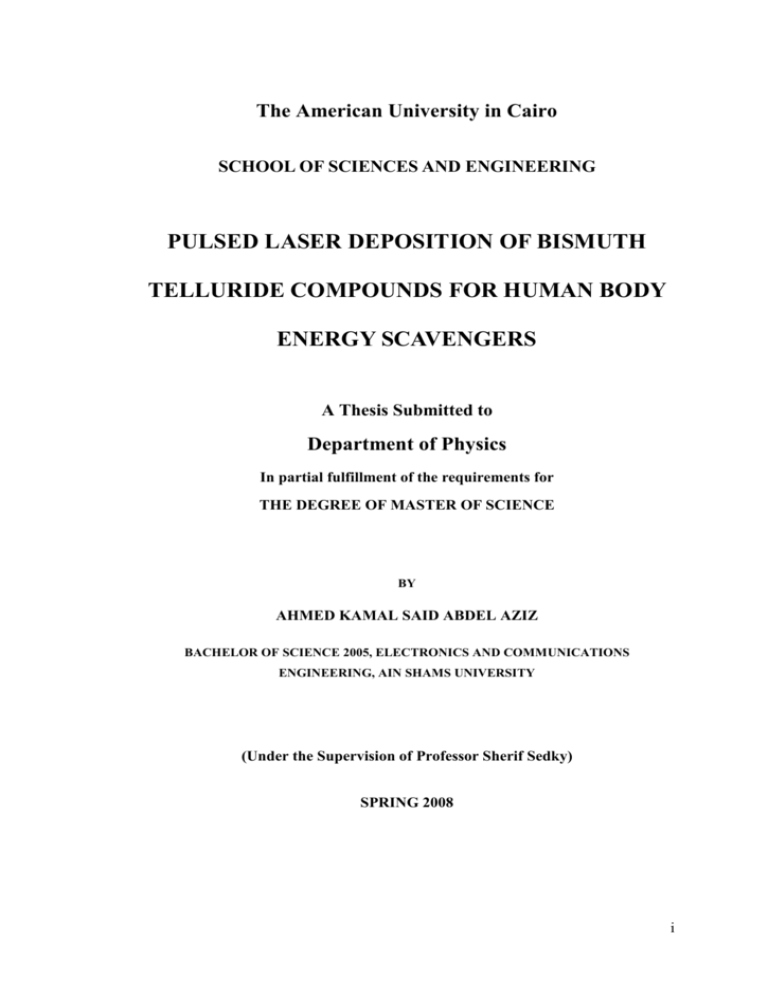
The American University in Cairo SCHOOL OF SCIENCES AND ENGINEERING PULSED LASER DEPOSITION OF BISMUTH TELLURIDE COMPOUNDS FOR HUMAN BODY ENERGY SCAVENGERS A Thesis Submitted to Department of Physics In partial fulfillment of the requirements for THE DEGREE OF MASTER OF SCIENCE BY AHMED KAMAL SAID ABDEL AZIZ BACHELOR OF SCIENCE 2005, ELECTRONICS AND COMMUNICATIONS ENGINEERING, AIN SHAMS UNIVERSITY (Under the Supervision of Professor Sherif Sedky) SPRING 2008 i Pulsed Laser Deposition of Bismuth Telluride Compounds for Human Body Energy Scavengers ABSTRACT The world wide research interest in Bismuth Telluride thin films is due to the fact that they are the most commonly efficient thermoelectric materials at temperatures as low as room temperature, which is typically suitable for implementing such thin films through the fabrication of miniaturized thermoelectric generators and human body energy scavengers. This work aims to characterize various Bismuth Telluride -based thin films deposited by Pulsed Laser Deposition technique in order to optimize their thermoelectric performance represented in their thermoelectric figures of merit. This has been achieved by investigating the electrical and thermoelectric properties of the deposited thin films as well as studying the structural properties of such thin films that is necessary for future micromachining and fabrication of energy scavengers; the results of this effort are really promising. The first chapter is an introductory overview concerning thermoelectric effects and thermoelectric generators. The second chapter deals with the different deposition techniques and the reasoning behind the employment of PLD to deposit Bismuth Telluride thin films. The third chapter includes some of Bismuth Telluride chemical and physical properties in addition to a literature survey of what other groups have already achieved concerning this material. The fourth chapter covers all the experiments and includes the results of this work. Finally, the fifth chapter includes the summary, conclusion and recommendation for future progress in this topic. ii ACKNOWLEDGEMENTS I am strongly grateful to Mr Youssef Al-Jameel for offering me a great opportunity to conduct researches as well as funding all my thesis expenses. I would like to express my sincere gratitude to my supervisor, Professor Sherif Sedky, for all his uninterruptable help, patience and encouragement during every moment I spent in the completion of this work. I am grateful to Professor Fadel Assabghy for his generous support and allowing me to utilize many fine instruments within STRC. This work would not have been completed without the great help of Joumana El-Rifai and Hassan Abu Bakr in processing some of my samples, and being a friendly and driving force to complete this thesis. I would also like to thank my colleagues during my stay at STRC, especially Ahmed Nagy, Mohammed Elwi, Ahmed Bayoumy, Ahmed Alaa, Nouran Ashraf, Ramy Wasfi, and Deena Gendoo for their very kind support, technically and morally. Last but not least, I am indebted to my parents for always being there during my times of distress, and their encouragement during my success. “This thesis is dedicated to my parents and fiancée” iii LIST OF ABBREVIATIONS AFM Atomic Force Microscopy CFD Computational Fluid Dynamics COP Coefficient of Performance CVD Chemical Vapor Deposition EMF Electro-Motive Force FPP Four Point Probe HV High Vacuum IC Integrated Circuit KrF Krypton Fluoride LIF Laser Induced Fluorescence LPTG Low Power Thermoelectric Generator MBE Molecular Beam Epitaxy MEMS Micro-Electro-Mechanical Systems MZ Mach-Zender OES Optical Emission Spectroscopy PID Proportion-Integration-Differentiation PLD Pulsed Laser deposition PSF Peak Shape Function PVD Physical Vapor Deposition SEM Scanning Electron Microscopy TEG Thermoelectric Generator TEM Transmission Electron Microscopy TOF Time of Flight XRD X-Ray Diffraction iv XRF X-Ray Fluorescence YBCO Yttrium Barium Copper Oxide v TABLE OF CONTENTS 1. Overview of Thermoelectric Generators 1 1.1. Introduction 1 1.2. Thermoelectricity 1 1.2.1. Seebeck Effect 3 1.3. Overview of Thermoelectric Materials 7 1.4. Modern Thermoelectric Materials 11 1.5. Summary 14 References 16 2. Thin Film Deposition Techniques 19 2.1. Introduction 19 2.2. Common Thin Film Deposition Techniques 19 2.3. Pulsed Laser Deposition 22 2.4. Ablation-Deposition Process 24 2.5. Summary 30 References 32 3. Bismuth Telluride Compounds 36 3.1. Introduction 36 3.2. Bismuth Telluride Alloys 37 3.3. Overview of Bismuth Telluride Development 45 3.4. Summary 48 References 49 4. Characterization of Bismuth Telluride Thin Films prepared by PLD 4.1. Introduction 53 53 vi 4.2. Sample Preparation and Experimental Setup 53 4.3. Effect of PLD Parameters on Film Surface Roughness 56 4.4. Effect of PLD Parameters on Film Microstructure 60 4.5. Effect of PLD Parameters on Film Stoichiometry 64 4.5.1. X-Ray Fluorescence Setup 65 4.5.2. X-Ray Diffraction Texture 65 4.5.3. XRF and XRD Data Analysis 70 4.6. Effect of PLD Parameters on Thermoelectric Properties 77 4.7. Effect of Thermal Annealing 81 4.8. Effect of Laser Annealing 82 4.9. Data Analysis 84 4.10. 94 Summary References 5. Optimization Results of Binary Bismuth Telluride Alloys 95 99 5.1. Introduction 99 5.2. Thermoelectric Results of Binary Bi-Te Alloys 99 5.3. Summary 102 6. Thesis Summary and Conclusion 104 vii LIST OF FIGURES Figure 1.1: Illustrative diagram demonstrating how the Seebeck voltage is created between hot and cold junctions, where A and B are two dissimilar conductors 3 Figure 1.2: Figure of merit of various thermoelectric material types where the horizontal axis is the charge carrier concentration and the vertical axis is Seebeck coefficient, electrical conductivity, thermal conductivity or thermoelectric figure of merit, all with arbitrary units 9 Figure 1.3: Typical conversion efficiency curves 10 Figure 1.4: Available thermoelectric materials 11 Figure 1.5: Schematic diagram of a semiconductor–based thermoelectric cooler 12 Figure 1.6: Schematic diagram of a semiconductor –based thermoelectric generator 12 Figure 1.7: Roadmap of Thermoelectric materials 14 Figure 2.1: Basic schematic setup of Pulsed Laser Deposition (PLD) technique 24 Figure 2.2: Schematic illustration of ablation plume spatial occupation 28 Figure 3.1: Schematic for Bi2Te3 rhombohedra crystal structure 37 Figure 3.2: Reproduced data of thermal conductivity of Bi2Te3 39 Figure 3.3: Reproduced data of Seebeck coefficient of Bi2Te3 40 Figure 3.4: Reproduced data of electrical resistivity of Bi2Te3 41 Figure 3.5: Reproduced data of the figure of merit Z of Bi2Te3 42 Figure 3.6: Reproduced data of Bi2Te3 electrical conductivity temperature dependence 43 Figure 3.7: Reproduced data of Bi2Te3 Seebeck coefficient temperature dependence 44 viii Figure 4.1: Schematic PLD setup which has been employed in this work 54 Figure 4.2: a) SEM image of (Bi0.25Sb0.75)2Te3 when the laser fluence is 0.7J/cm2 and the deposition pressure is 10-3 mbar in Argon; scale bar is 1m. b) The laser fluence is 0.7J/cm2 and the deposition pressure is 10-2 mbar. c) The laser fluence is 0.7J/cm2 and the deposition pressure is 10-1mbar. d) The laser fluence is 1Jcm-2 and the deposition pressure is 10-1mbar. e) The laser fluence is 1.25 J/cm2 and the deposition pressure is 10-1 mbar 58 Figure 4.3: a) SEM image of (Bi0.25Sb0.75)2Te3 when the substrate temperature is 300K, laser fluence is 1.4 J/cm2 and the deposition pressure is 10-3mbar in Argon; scale bar is 100m. b) the substrate temperature is 673K 59 Figure 4.4: AFM image of 600nm thick (Bi0.25Sb0.75)2Te3 deposited at 0.7 J/cm2, 103 mbar and 400C; average roughness is 12nm 60 Figure 4.5: TEM cross-section of a 1.5m thick (Bi0.25Sb0.75)2Te3 where the laser energy density is 0.7J/cm2, deposition pressure is 10-1 mbar and substrate temperature is 100C 61 Figure 4.6: TEM cross-section of a 1.5m thick (Bi0.25Sb0.75)2Te3 where the laser energy density is 0.7 J/cm2, deposition pressure is 10-1mbar and substrate temperature is 200°C 62 Figure 4.7: TEM cross-section of a 0.6m thick (Bi0.25Sb0.75)2Te3 deposited using a laser energy density is 0.7 J/cm2, deposition pressure of 10-1mbar and a substrate temperature of 400°C 62 Figure 4.8: TEM cross-sections for Bi64Te36 deposited thin films at 300C in (a) and 600C in (b) 63 ix Figure 4.9: TEM cross-sections for two (Bi0.25Sb0.75)2Te3 1.5m thick films deposited on Si3N4 substrate; at different deposition pressures. (a) 10-2mbar and (b) 10-1mbar 64 Figure 4.10: Schematic illustration of the four basic steps of constructing the intensity-angle dependence of a XRD texture 67 Figure 4.11: Schematic illustration of peak broadening effect as a direct consequence of uncontrolled spectral purity (i.e. chromatic source) 69 Figure 4.12: the dependence of relative elemental compositions in (Bi0.25Sb0.75)2Te3 on the deposition pressure 70 Figure 4.13: the dependence of relative elemental compositions in (Bi0.25Sb0.75)2Te3 on the laser energy density (at a deposition pressure of 0.1 mbar) 71 Figure 4.14: XRD patterns showing the dependence of relative elemental compositions in (Bi0.25Sb0.75)2Te3 on the deposition pressure 73 Figure 4.15: XRD patterns for Bi64Te36 target and deposited thin films revealing the effect of the substrate temperature on the relative elemental compositions of the deposited thin films with respect to that of the target 75 Figure 4.16: XRD patterns for Bi55Te45 target and deposited thin films revealing the effect of the substrate temperature on the relative elemental compositions of the deposited thin films with respect to that of the target 76 Figure 4.17: The dependence of the electrical conductivity of the different p-type binary and ternary alloys on the substrate temperature 78 Figure 4.18: The dependence of Seebeck coefficient of (Bi0.25Sb0.75)2Te3 thin films deposited at room temperature on the deposition pressure 80 Figure 4.19: The dependence of Seebeck coefficient of various (Bi0.25Sb0.75)2Te3 thin films on the thermal annealing temperature 82 x Figure 4.20: SEM image of a 0.7m thick (Bi0.25Sb0.75)2Te3 thin film deposited at room temperature showing the unexposed part (left) and the 200mJcm-2 single pulse exposed part (right) showing the total ablation of the deposited thin film 84 xi LIST OF TABLES Table 4.I: Summary of the major parameters affecting the various diffraction pattern components 66 Table 4.II: The dependence of the power factor for Bismuth Telluride based compounds prepared under different conditions 93 Table 5.I: Optimal Results for the Power Factor of As-Grown Thin Films of N-type Bi36Te64 and P-type Bi45Te55 Compounds 100 Table 5.II: Optimal Results for the Power Factor of Laser Annealed Thin Films of Ntype Bi36Te64 and P-type Bi45Te55 Compounds 102 xii
